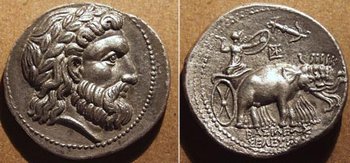Seleucid Empire
|
|
The Seleucid Empire was one of several political states founded after the death of Alexander the Great, whose generals squabbled over the division of Alexander's empire.
There were over 30 kings of the Seleucid dynasty from 323 to 60 BC.
| Contents |
The partition of Alexander's empire (323-281 BC)
Alexander the Great left an expansive empire of Persio-Greek culture to his successors (the Diadochi or Diadochoi), who jostled for supremacy over portions of his empire.
The empire was initially divided among several generals, chiefly Ptolemy Soter in Egypt, Antigonus Monopthalmos (literally "One-eyed") in Greece, and Seleucus in the Mideast.
Of these, Seleucus I Nicator founded the Seleucid Empire in 312 BC, when he took back his initial capital in Babylon. At its height, it controlled a large region including modern-day Israel, Syria, Lebanon, Jordan, Iraq, Iran, Tajikistan, Pakistan and much of Afghanistan and the other Central Asian states.
By about 281 BC, only two dynasties divided most of Alexander's empire — the Seleucid dynasty in the east and the Ptolemaic dynasty in the south.
Invasion and loss of India (304 BC)
Seleucus invaded India (modern Punjab in northern India and Pakistan) in 304 B.C., which was then the Mauryan empire ruled by Chandragupta Maurya. It is said that Chandragupta put an army of 100,000 men and 9,000 war elephants and forced Seleucus to conclude an alliance and to give him his daughter in marriage.
Seleucus sent an ambassador named Megasthenes to Chandragupta's court, who repeatedly visited Pataliputra (modern Patna in Bihar state), capital of Chandragupta. Megasthenes has written detailed descriptions of India and Chandragupta's reign.
Death of Seleucus I (281 BC)
Other territories were lost (Gedrosia on the coast of the Arabian Sea and Arachosia on the west of the Indus River) until Seleucus was assassinated in 281 B.C. The Seleucid Empire disintegrated soon after into Parthia (Arsaces as King), Syria (Antiochus I as king) and Bactria (Diodotus as king).
Greco-Bactrian secession (250 BC)
Diodotus, who was governor for the Bactrian territory, asserted independence in 250 BC to form the Greco-Bactrian kingdom. This kingdom was characterized by a rich Hellenistic culture, and was to continue its domination of Bactria until around 125 B.C., when it was overrun by the invasion of northern nomads. One of the Greco-Bactrian kings, Demetrius I of Bactria, invaded India from 180 B.C. to form the Greco-Indian kingdom, which was to last until 1 B.C.
Parthian secession (250 BC)
A Parthian tribal chief called Arsaces took over the Parthian territory of the Seleucid Empire around 250 B.C. as well, to form the Arsacid Dynasty, starting point of the powerful Parthian Empire.
Greek and Judean campaigns (198 BC)
Antiochus III the Great is considered the greatest of the Seleucid monarchs, but his campaigns in Greece in 192 BC attracted the attention of the Roman Republic, which exacted punitive war indemnities.
Antiochus and Philip V of Macedon made a compact to divide the Ptolemaic possessions overseas and the Seleucids ousted Ptolemy V from control of the former Kingdoms of Judah and Israel (which had been occupied for 400 years by Babylonians and then Persians until the conquests of Alexander). The Battle of Panium (198) definitely transferred these holdings from the Ptolemies to the Seleucids.
His successor, Antiochus IV Epiphanes, ascended the throne in 180 BC, but his attempt to outlaw the observance of Judaism precipitated armed rebellion led by Jewish zealots known as the Maccabees. The Hasmonean Jewish Kingdom was established in 166 BC, and in 142 BC the Seleucids recognized Jewish autonomy. (See also: Hanukkah).
End of the Empire
By 100 BC the once formidable Seleucid Empire encompassed little more than Antioch and some Syrian cities. Despite the clear collapse of their power and the decline of their kingdom around them, nobles continued to play kingmakers on a regular basis with occasional intervention from Ptolemaic Egypt and other outside powers. The Seleucids existed only because no other nation wanted to absorb them, seeing them as a useful buffer against one or more of their other neighbors. In the wars between Mithridates VI of Pontus and Sulla of Rome in Anatolia, the Seleucids were left largely alone by both major combatants. However, after the conquest of Pontus by Rome, the Romans became increasingly alarmed by the constant source of instability in Syria under the Seleucids. After Mithridates was defeated by Pompey in 63 BC, Pompey set about remaking the Hellenistic East by creating new client kingdoms and establishing provinces. While nations like Armenia and Judea were allowed to continue their rule under local kings, Pompey saw the Seleucids as too troublesome to continue on, and so, while the Seleucids were in the middle of yet another civil war, he annexed Syria and ended the House of Seleucus.
In modern media
The Seleucid Empire is one of a number of factions in the 2004 PC game Rome: Total War.

